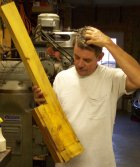butchlambert
Site $$ Sponsor
Dang! Now I have to go digging! I know I have an LC Smith Ideal grade but can’t remember if it’s a 16 or 12 gauge. I have my Dad’s last Parker, but can’t remember what it is. I know it’s a 12 gauge with longer than normal barrels and full/full. It was his Turkey gun.
Looking for a double shotgun for a build.














